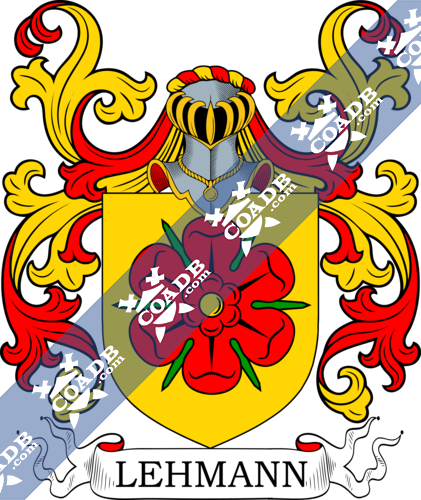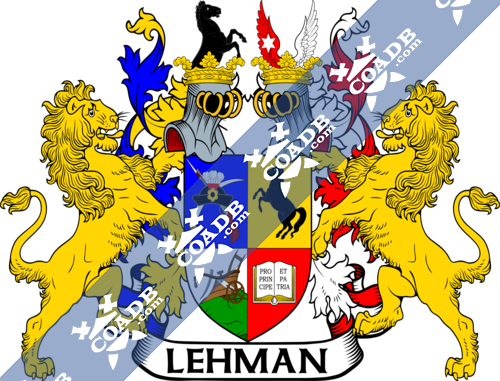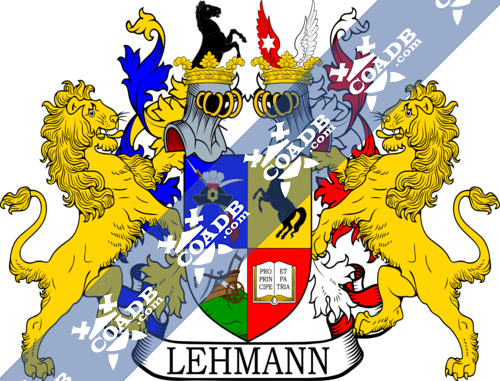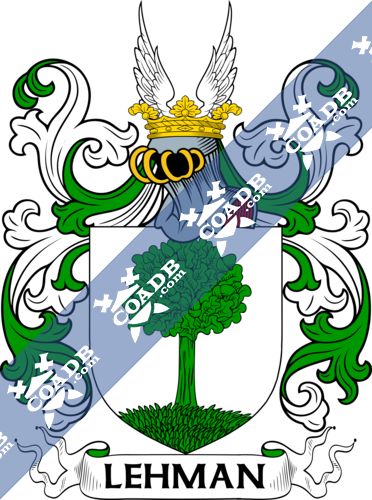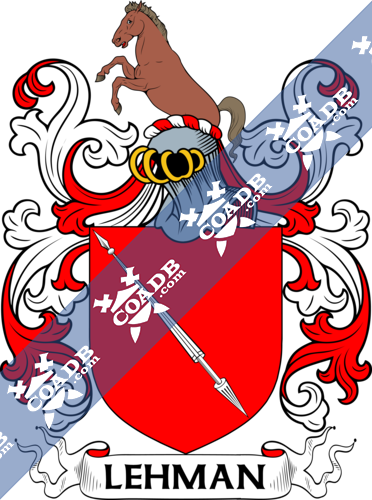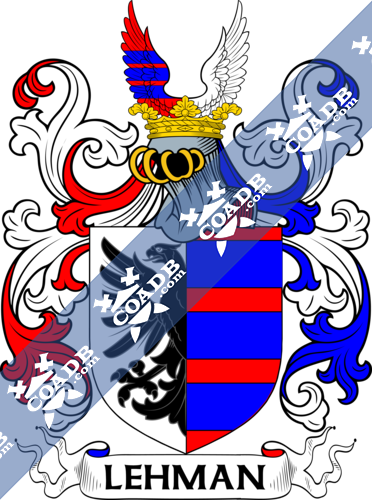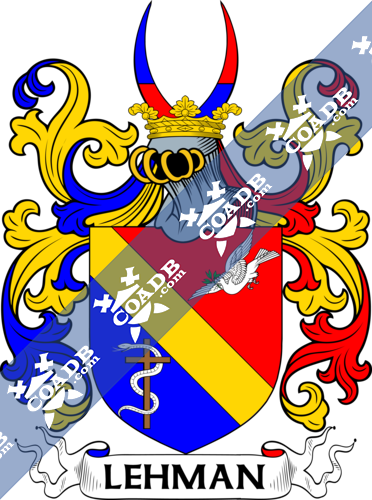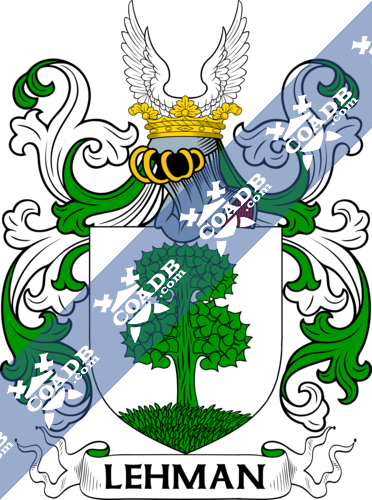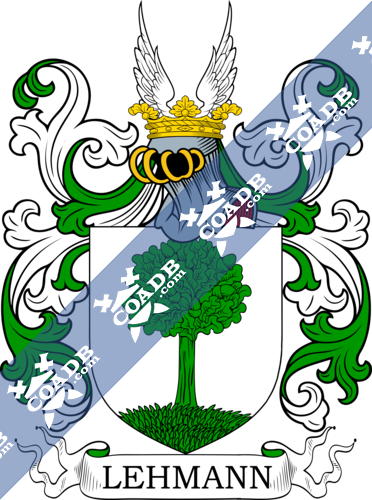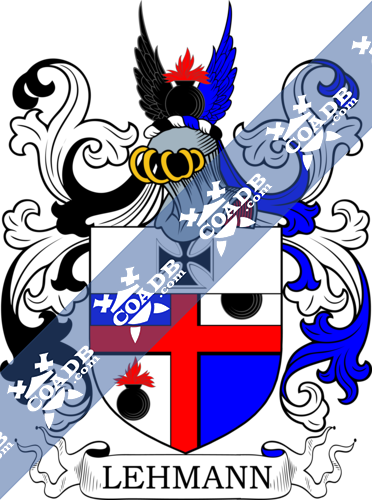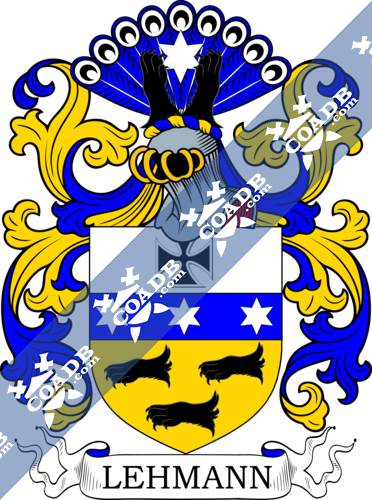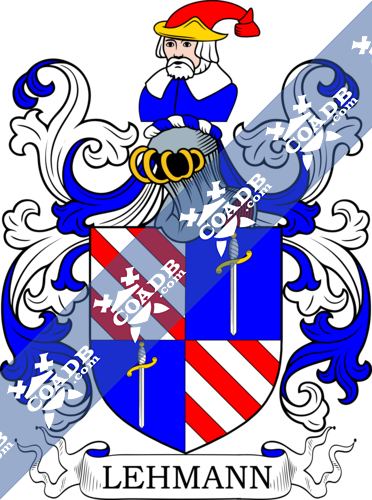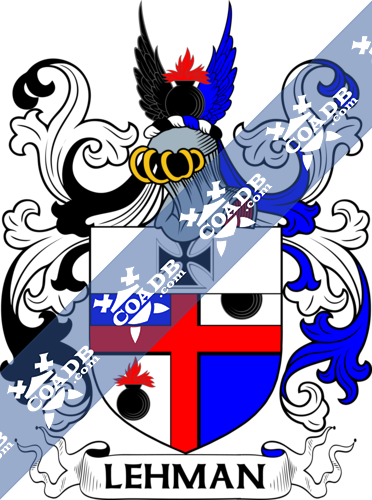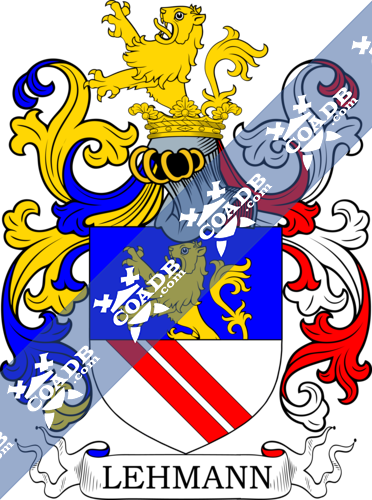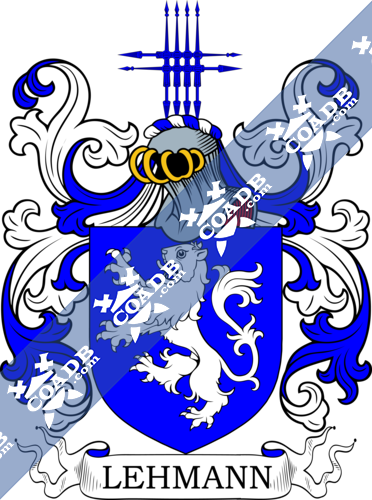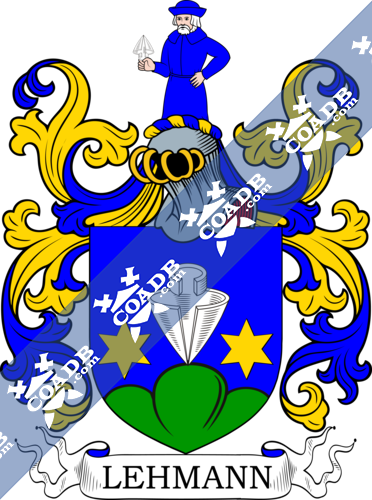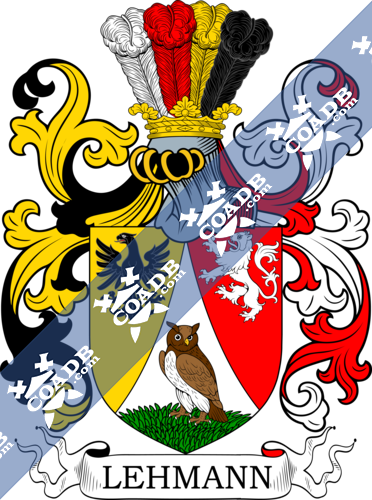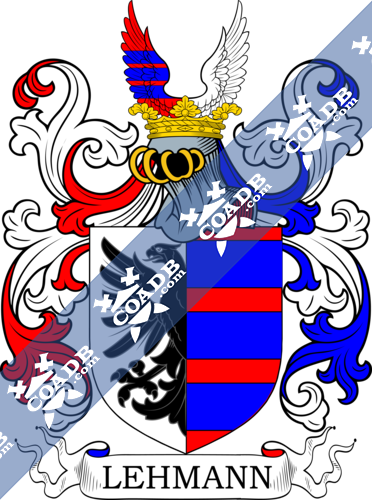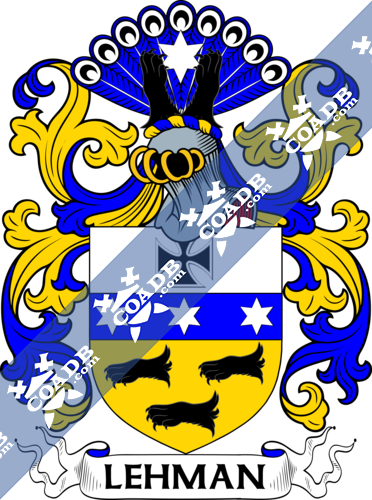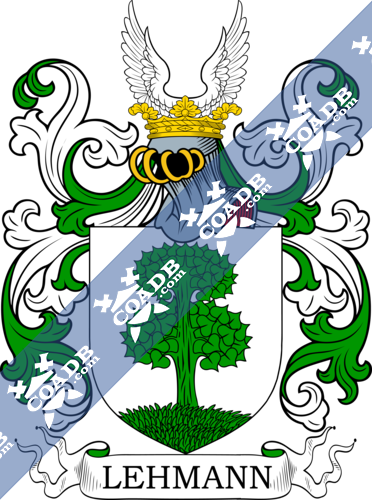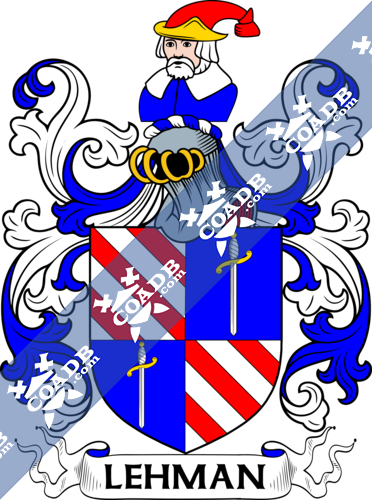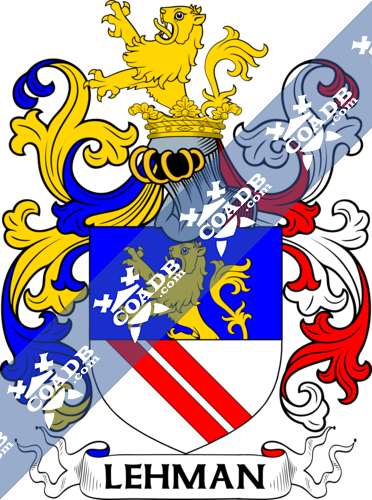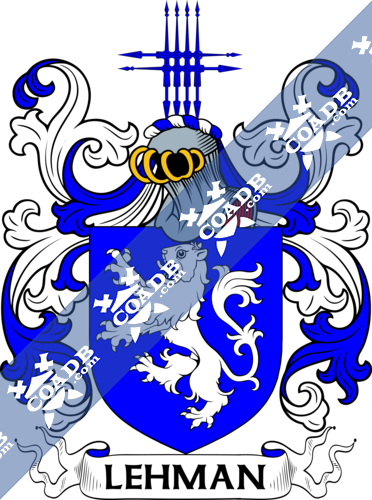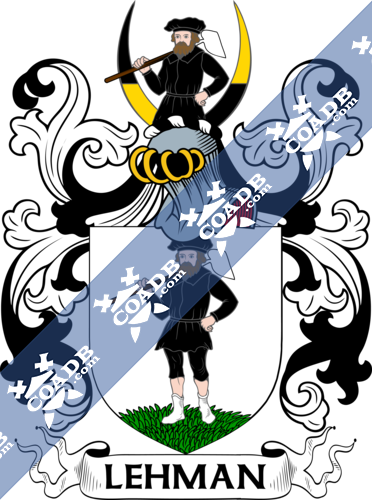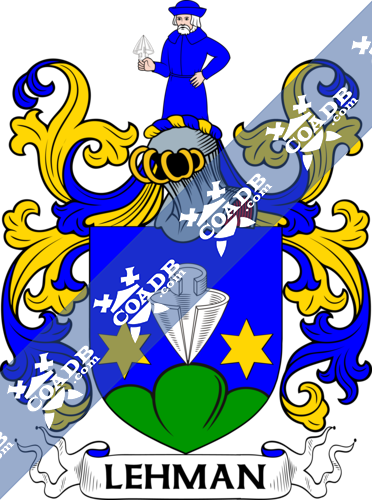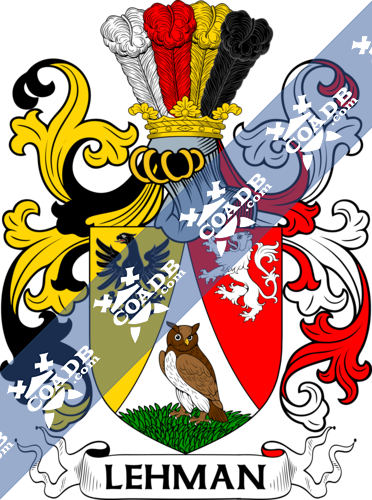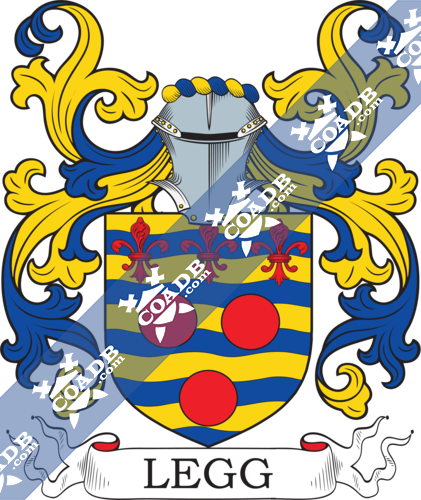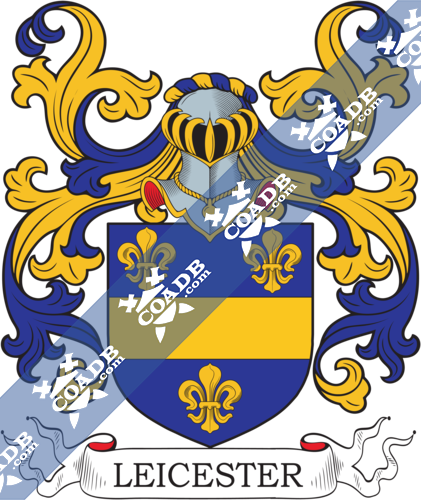Lehman Family Crest, Coat of Arms and Name History
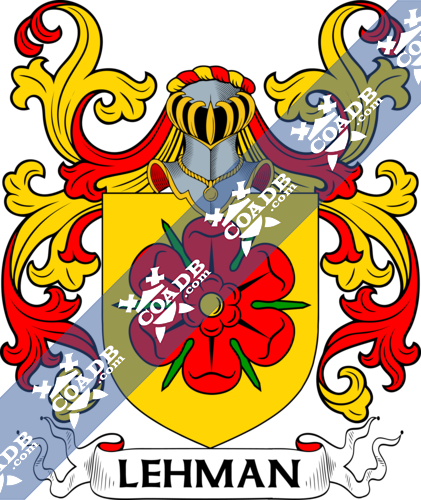
Lehman Coat of Arms Gallery
Don’t know which Coat of Arms is yours?
We can do a genealogical research. Find out the exact history of your family!
Learn MoreLehman Origin:
England, Germany, Switzerland, Jewish
Origins of Name:
The surname Lehman is derived from the Anglo-Saxon baptismal name for son of Leman, which originates from the Anglo-Saxon name Liefman.. In Germany, surnames were often derived from occupations, as well as through patronymic means. Lehman was said to have meant “vassal,” or someone who works the land, such as a “fief” or peasant who had no ownership of land. A fief was bound to one landowner and the land until his services were completed. Lehman is the 11,765 most common surname in the world, and approximately 45,433 people in the world bear this surname.
Variations:
More common variations are:
Lehman, Leahman, Luehman, Loehmn, Lehmani, Leehman, Liehman, Leihman, Lehmane, Llehman, Leyhman, Leuhman, Leohman, Lemanh, Lehmanh, Lehmaun, Lehmman, Laehman, Leman, Lemon, Limon, Leaman
History:
England:
The first record of the Lehman name was found in Suffolk at Wenhaston. This parish was found in the hundred of Blything, and the Leman family was said to have a seat in this organization. According to record, the Leman family was a prominent clan within this parish, as the church has various monuments dedicated to this family. Many Anglo-Saxon names were spelled according to the location and level of literacy of the person recording the name. When the English Poll Tax was enacted, surnames became required so that the English government could impose personal taxation. When these surnames were recorded, the spelling often relied on the phonetic spelling of the surname, and was recorded as such. For this reason, many forms of Lehman were recorded throughout English history, but it is plausible that many of them originated from the same family, and same area. Many of those with the surname Lehman were fiefs, or indentured servants, and their name was based off of their occupation, which was to toil and till the land until their service was up. “Lehman” directly translates to the word “vassal.” Since many of the Lehmans were fiefs and vassals, it is possible that the spellings of their names became different due to their ownership, and literacy, as well as the recorder.
Germany/Switzerland:
It is said that the surname Lehman originated from a Mennonite family who lived in the Emmental. Emmental was a word used to describe those who lived in the Emme River Valley in Canton of Bern, Switzerland. The Mennonite people believe that those who carry the name Lehman originally lived on “a gentle slope.” Emigration from the Canton of Bern began In the late seventeenth century, from 1660-1675. At this time, immigrants were being forced to migrate out of the Canton of Bern. These immigrants ended up in Lancaster County, in the state of Pennsylvania, and the name Lehman was among them.
United States:
In the late seventeenth century, Philip Theodore Lehman arrived in Philadelphia, Pennsylvania, following the immigrants from German-Speaking-Switzerland. Soon after, in 1713 Clemens Lehman arrived in New York with Anna Gertraud Wolf Lehman, his wife. Eight years later, in 1721, Hans Lehman settled in Philadelphia, Pennsylvania, with his wife Anna Hege Lehman, and their three small children, while in 1727, Hans Jerig Lehman also settled in Pennsylvania. Four years later, three-year-old Kathrina Lehman, and one-year-old Johanis Lehman landed in Pennsylvania. In the nineteenth century, Nicholas Lehman, Daniel Lehman, and Christ Lehman arrive in Pennsylvania in the year 1806. Eighteen years after, Catherine Lehman settled in New York City, New York in 1824, and eight years after that, twenty-one-year-old Charles Lehman also arrived in New York City, NY in 1832.
The most prominent and famous family in the United States has been a Jewish family. Henry Lehman arrived in the US from northern Bavaria in 1844, his brother Emanuel came in 1847, and the last brother Mayer Lehman came in 1850. They opened a dry goods store in Alabama and eventually moved into cotton trading.
The younger brother Mayer Lehman was one of the original organizers of the New York Cotton Exchange, and with his direction the family moved into financial services.
Australia
The Lehman family was split in Australia to be approximately one quarter of the surnames spelled Lehman, and three quarters of the surname spelled Lehmann.
Lehman Today:
United States 36,699
Canada 1,897
Germany 1,143
South Africa 950
Austrailia 936
Cameroon 595
France 539
Brazil 397
Poland 334
Israel 306
Notable People:
Major-General Raymond Godfrey Lehman (1895-1964) Commanding General in the 93rd Division, Pacific from 1943 to 1945, American
Trenton Lawson “Trent” Lehman (1961-1982) was a child actor in America
Lillian Lehman (born in 1947) was an actress in America
Henry Lehman (1822-1855) was the founder of the Lehman Brothers financial services, and was a German-American businessman
Philip Lehman (1861-1947) was an investment banker, and the partner and co-founder of the Lehman Brothers investment bank, Jewish-American
Robert Lehman (1891-1969) worked as the head of the Lehman Brothers investment bank alongside Philip Lehman, was a banker in America
Teddy Lehman (born in 1981) is a linebacker (American football player)
Richard Henry “Rick” Lehman (born in 1948) was a former member of the United States House of Representatives
Kenneth Karl Lehman (1928-2010) was an MLB (Major League Baseball) relief pitcher in America
Jeffery Sean Lehman (born in 1956) is an American academic administrator, scholar, and lawyer
Blazons & Genealogy Notes
1) Prusse – (An., 18 janv. 1701) D’argent à un arbre de sinople planté dans un pré du même Casque couronné Cimier un vol d’argent. English: On silver a green tree planted on green grass, crest: silver wings on a crowned helmet.
2) Prusse – (An., 16 juin 1871) Écartelé d’azur et d’argent l’argent chargé d’une grenade de sable allumée de gueules A la croix de gueules brochant sur les écartelures Au chef de l’écu d’argent brochant sur l’écartelé et ch de la Croix de fer Cimier la grenade entre un vol de sable et d’azur Lambrequin à dextre d’argent et de sable à senestre d’argent et d’azur. English: Per cross Azure and Argent, each of the Argent quarters charged with a grenade Sable fired Gules, overall a cross Gules all surmounted by a chief Argent charged with the Iron Cross. Crest: A grenade [as in the arms] between two wings, dexter Sable, sinister Azure. Mantling Argent and Sable on the dexter side, Argent and Azure on the sinister.
3) Prusse – (An., 16 juin 1871) Coupé au 1 d’azur à trois étoiles d’argent rangées en fasce au 2 d’or à trois pattes d’ours de sable posées chacune en fasce 2 et 1 les ongles à senestre Au chef de l’écu d’argent ch de la Croix de fer Cimier deux pattes d’ours de sable posées en pals tenant ensemble une étoile d’argent devant cinq plumes de paon au naturel Lambrequin d’or et d’azur. English: Per fess, Azure three stars in fess Argent and Or three bear paws fesswise Sable, 2 and 1, the claws to sinister; overall a chief Argent charged with the Iron Cross. Crest: Two bear’s paws palewise Sable holding a star Argent, all before five peacock plumes proper. Mantling Or and Azure.
4) Winterthür Écartelé aux 1 et 4 bandé d’argent et de gueules aux 2 et 3 d’azur à une épée d’argent garnie d’or la pointe en bas Cimier un buste d’homme habillé d’azur au rabat d’argent coiffé d’un bonnet de gueules retroussé d’or Lambrequin d’argent et d’azur. English: Quarterly, 1st and 4th bendy Argent and Gules; 2nd and 3rd Azure a sword point downward Argent garnished Or. Crest: A man’s bust vested Azure with collar Argent wearing a bonnet Gules turned up Or. Mantling: Argent and Azure.
5) Saxe, Mecklembourg, Prusse – (Nob. du St.-Empire, 1556; conf. de nob., 30 juillet 1703) Coupé au 1 d’azur au lion naissant d’or mouv du coupé au 2 d’argent à deux bandes de gueules Casque couronné Cimier le lion issant Lambrequin à dextre d’or et d’azur à senestre d’argent et de gueules. English: Per fess, Azure a demi-lion issuant Or and Argent two bendlets Gules. Crowned helm. Crest: The demi-lion [as in the arms]. Mantling Or and Azure on the dexter side and Argent and Gules on the sinister.
6) Saxe – (Nob. du St.-Empire, 1 juin 1792) D’azur au lion d’argent Cimier quatre lances de tournoi d’argent deux posées en pals et les deux autres brochant en fasces réunies sur les points d’intersection par des annelets d’azur la lance qui est supérieure ayant le fer à senestre. English: Azure a lion rampant Argent. Crest: Four tourney lances palewise superimposed by two more fesswise, all joined at the points of intersection by annulets Azure, the upper lance having its point to sinister.
7) Nuremberg D’or à un paysan habillé de sable coiffé d’un chapeau du même les bas d’argent posé sur une terrasse de sinople et tenant de sa main dextre un hoyau posé sur son épaule Cimier le paysan issant entre deux proboscides coupées alternativement de sable et d’or. English: Or a peasant vested Sable with a cap of the same, stockings Argent, standing on a terrace Vert and holding over his dexter shoulder a hoe [proper] Crest: A demi-peasant issuant [as in the arms] between two elephant tusks/buffalo horns per fess alternately Sable and Or (i.e., the dexter Sable and Or, the sinister Or and Sable].
8) Berne D’azur à un soc de charrue d’argent la pointe en bas accosté en pointe de deux étoiles d’or et soutenu d’un tertre de sinople Cimier un homme issant habillé d’azur coiffé d’un chapeau du même tenant de sa main dextre un soc de charrue d’argent la pointe en haut ou un trèfle de sinople. English: Azure a plowshare point downward Argent between in base two stars Or, [the point digging into] a mound Vert. (A German heraldic plowshare looks like the head of a farmer’s spade.) Crest: A demi-man vested Azure with a cap of the same holding in his dexter hand a plowshare point upward Argent or a trefoil Vert. [Not sure if the trefoil is an alternative to the complete crest or just to the plowshare.]
9) (Edle von) – Styrie – (An., 10 juillet 1780) D’argent à une chouette au naturel posée sur une terrasse de sinople le champ chapé-ployé à dextre d’or à l’aigle de sable languée de gueules à senestre de gueules au lion d’argent Casque couronné Cimier quatre plumes d’autruche d’argent de gueules d’or et de sable Lambrequin à dextre d’or et de sable à senestre d’argent et de gueules. English: Argent upon a terrace Vert an owl proper, the field chapé-ployé to dexter Or an eagle displayed Sable langued Gules and to sinister Gules a lion rampant Argent. Crowned helm. Crest: Four ostrich plumes Argent, Gules, Or, and Sable. Mantling: Dexter Or and Sable, sinister Argent and Gules.
10) (Edle von) – Autriche – (An., 1 fév. 1869) De gueules à une lance de tournoi d’argent posée en bande Cimier un cheval bai issant. English: Gules a tilting lance bendwise Argent. Crest: A bay horse issuant [proper].
11) Hesse – (Barons du St.-Empire, 17 juillet 1790) Parti au 1 d’argent à la demi-aigle de sable mouv du parti au 2 de gueules à trois fasces d’azur Casque couronné Cimier un vol à l’antique l’aile de derrière d’argent plein l’aile de devant aux armes du 2 Lambrequin d’argent et d’azur. English: Per pale, dexter Argent an eagle displayed dimidiated issuant from the partition line Sable; sinister Gules three bars Azure [sic]. Crowned helm. Crest: An antique vol, the rear [sinister?] wing Argent, the forward [dexter?] wing as in the sinister half of the arms.
12) Hesse D’or à une rose de gueules boutonnée du champ barbée de sinople (V Scholley). English: Or a rose Gules seeded Or and barbed Vert.
13) Bohême – (Chevaliers, 1 juillet 1842; barons, 15 août et 3 nov. 1867) Écartelé au 1 d’azur à un sabre d’argent garni d’or et un fusil avec sa baïonnette au naturel passés en sautoir et un chapeau de sable brochant sur le point d’intersection ledit chapeau orné sur le devant d’une cocarde de sable et d’or derrière laquelle s’élève un panache coupé d’argent sur gueules au 2 d’or à un cheval cabré de sable au 3 d’argent à une charrue à deux roues au naturel sur une terrasse de sinople au 4 de gueules à un livre ouvert d’argent doré sur tranche la feuille dextre inscrite des mots PRO PRIN CIPE disposés sur trois lignes et la feuille senestre portant les mots ET PA TRIA pareillement sur trois lignes Deux casques couronnés Cimiers 1° un cheval issant et contourné de sable Lambrequin d’or et d’azur 2° un vol à l’antique de gueules et d’argent l’aile de gueules ch d’une étoile d’argent Lambrequin d’ et de gueules Supports deux lions d’or. English: Quarterly, 1st Azure a sabre Argent garnished Or and a rifle with bayonet fixed proper crossed in saltire, surmounted by a chapeau [apparently a cocked hat] Sable adorned with a panache of feathers per fess Argent and Gules behind a cockade Sable and Or; 2nd Or a horse forcene Sable; 3rd Argent a plow with two wheels proper upon a terrace Vert; 4th Gules an open book Argent gilt on the edges, the dexter page inscribed in three lines “PRO PRIN CIPE,” the sinister also in three lines “ET PA TRIA.” Two crowned helms. Crests: (1) A horse issuant contourny Sable; mantling Or and Azure; (2) An antique vol Gules and Argent, the wing Gules charged with a star Argent; mantling Gules. Supporters: two lions Or.
14) (de Lehnsfeld) Hollande – (Nob. du St.-Empire, 15 juillet 1698) Tranché au 1 de gueules à une colombe volante d’argent en barre la tête en bas tenant en son bec un rameau d’olivier de sinople au 2 d’azur à une croix latine en bois (couleur brunâtre) accolée d’un serpent d’argent la tête à senestre A la bande d’or brochant sur le tranché Casque couronné Cimier deux proboscides coupées alternativement d’azur et de gueules Lambrequin d’azur et de gueules. English: Per bend, Gules a dove volant bendwise head to base Argent holding in the beak an olive branch Vert, and Azure a wooden Latin cross (brown color) supported on the sinister side by a serpent Argent; over all a bend Or. Crowned helm. Crest: Two elephant tusks/buffalo horns per fess, alternately Azure over Gules and Gules over Azure. Mantling Azure and Gules.
15) (de Lindegau) Prusse – (An., 5 mai 1818) D’argent à un tilleul doublement étagé de sinople terrassé du même Casque couronné Cimier un vol d’argent. English: Argent a linden tree of two stages [??] Vert on a terrace of the same. Crowned helm. Crest: a vol Argent.

